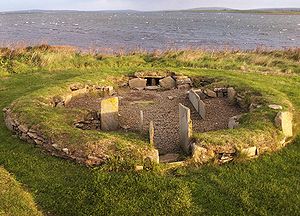
Barnhouse Settlement
Encyclopedia

Neolithic
The Neolithic Age, Era, or Period, or New Stone Age, was a period in the development of human technology, beginning about 9500 BC in some parts of the Middle East, and later in other parts of the world. It is traditionally considered as the last part of the Stone Age...
Barnhouse Settlement is sited by the shore of Loch of Harray, Orkney Mainland
The Mainland, Orkney
The Mainland is the main island of Orkney, Scotland. Both of Orkney's burghs, Kirkwall and Stromness, lie on the island, which is also the heart of Orkney's ferry and air connections....
, Scotland
Scotland
Scotland is a country that is part of the United Kingdom. Occupying the northern third of the island of Great Britain, it shares a border with England to the south and is bounded by the North Sea to the east, the Atlantic Ocean to the north and west, and the North Channel and Irish Sea to the...
, not far from the Standing Stones of Stenness. It was discovered in 1984. The base courses of at least 15 houses have been found. These houses have similarities to the better-known settlement at Skara Brae
Skara Brae
Skara Brae is a large stone-built Neolithic settlement, located on the Bay of Skaill on the west coast of Mainland, Orkney, Scotland. It consists of ten clustered houses, and was occupied from roughly 3180 BCE–2500 BCE...
in that they have central hearths, beds built against the walls and stone dressers, but differ in that the houses seem to have been free-standing. Pottery of the grooved ware
Grooved ware people
Most Neolithic cultures in Britain are best identified by the pottery remains which they left. A large number of apparently unrelated cultures seem to have produced urns which have characteristic grooves near the top rim, hence the name grooved ware people....
type was found, as at the Stones of Stenness and Skara Brae. Flint and stone tools were found, as well as a piece of pitchstone
Pitchstone
Pitchstone is a dull black glassy volcanic rock formed when viscous lava or magma cools swiftly. It is similar to but coarser than obsidian. It is a volcanic glass with a conchoidal fracture , a resinous lustre, and a variable composition. Its colour may be mottled, streaked, or uniform brown,...
thought to have come from the Isle of Arran
Isle of Arran
Arran or the Isle of Arran is the largest island in the Firth of Clyde, Scotland, and with an area of is the seventh largest Scottish island. It is in the unitary council area of North Ayrshire and the 2001 census had a resident population of 5,058...
.
The largest building had a room about 7 m (23 ft) square with walls 3 m (10 ft) thick and an entrance facing towards the north west so that the midsummer sunset shines along the passageway, with similarities to some chambered cairn
Chambered cairn
A chambered cairn is a burial monument, usually constructed during the Neolithic, consisting of a cairn of stones inside which a sizeable chamber was constructed. Some chambered cairns are also passage-graves....
s.
This site is accessible to the public via a footpath from the Standing Stones of Stenness.

